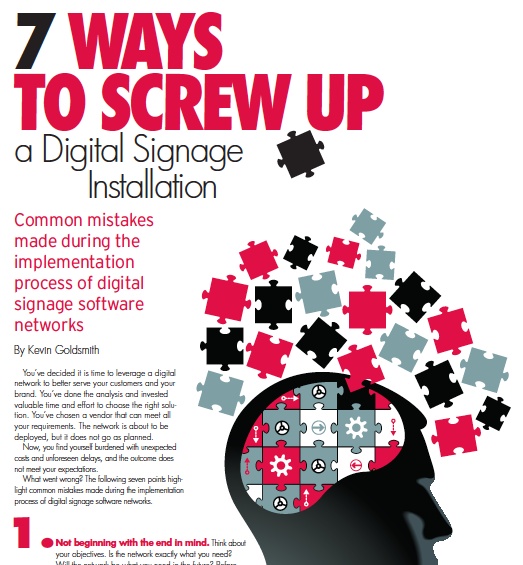Common mistakes made during the implementation process of digital signage software networks
You’ve decided it is time to leverage a digital network to better serve your customers and your brand. You’ve done the analysis and invested valuable time and effort to choose the right solution. You’ve chosen a vendor that can meet all your requirements. The network is about to be deployed, but it does not go as planned.
Now, you find yourself burdened with unexpected costs and unforeseen delays, and the outcome does not meet your expectations.
What went wrong? The following seven points highlight common mistakes made during the implementation process of digital signage software networks.
- Not beginning with the end in mind. Think about your objectives. Is the network exactly what you need? Will the network be what you need in the future? Before the planning and installation phases, think very carefully about the end game and how it will deliver on your brand promise, customer engagement and ROI objectives. Make sure these objectives are measureable and set up a process that ensures those objectives are being met. If they are not, find a solution with the flexibility to adapt to evolving objectives.
- Not including a pre-install site audit. Carry out a site survey. This is a very important part of the planning process that will save time, money and headaches. Ensure you have the right mount and mounting hardware; you don’t want the contractor making unplanned trips to Home Depot. Ceiling mounts may be problematic because of various factors, such as pipe length and drop-ceiling distance. The screens and media player hardware require power and access to a local area network or the Internet. Is the site prepped before installation commences? Are power and data connections already available? Are there restrictions with access times? Is union labor required? These are just some of the key items that need to be addressed before an installation date is even scheduled.
- Choosing the wrong software. There are many software options available, and they tend to fall into three main groups: standalone, on-premise client/server-based and Web-based SaaS. Each has its own merits, so look closely at your objectives and choose a solution that meets them. Think about the future. Understand how technology is changing and how it is becoming an important part of marketing and communication. There is tremendous gravitation toward the use of social media for marketing and brand awareness, which means it is essential to dynamically deliver these messages to the right place and at the right time. Look at the pricing model of each software vendor and identify exactly what you are getting. Are there costs for different features? Are there any hidden costs? Is the software scalable? It should be elastic and enable your digital network to expand or contract as you business requires. Also, make sure the software doesn’t require proprietary hardware.
- Choosing the wrong hardware. The environment plays a big part in ensuring you choose appropriate hardware. You cannot install a standard indoor LCD in a waterproof box and expect it to work in an outdoor sunlit environment. Consider the location (inside or outside) and make sure the hardware can effectively deliver your messaging. Will the screen(s) be big enough? Will the media player have enough power to run the content now and in the future? Compare the hardware warranty policies and ensure that the vendor can resolve any issue in a timeframe that is acceptable to you. If not, consider premium warranty services.
- Not thinking about the content. The customer doesn’t care how the content got there, what media players or software are being used; it’s all about the content. With HTML5 becoming more prevalent, it is essential to consider the content formats various hardware/software combinations can support. For example, Flash will be replaced by HTML5 eventually, but Apple’s mobile devices do not support Flash. Research indicates that digital displays attract 10 times the eye contact compared to static printed posters. So, take advantage of what is possible on a digital screen versus paper. Otherwise you’ll be left with nothing more than an expensive light box.
- Expecting too much from advertising revenue to offset cost. Be realistic and consider any revenue a bonus. While DOOH networks in aggregate capture more than 90 percent of TV viewers, advertising sales have not caught up yet. Advertising revenue success is achieved by capturing a large audience with a decent dwell time. Successful networks have a clearly defined demographic, e.g., in an airport. It makes sense for businesses that sell travel products and services to pay for ads at the airport.
- Not having the right service-level agreement. The digital signage network is installed and running. It is showing attractive and engaging content, and delivering the expected ROI, but then something fails. Who do you call? If your network encompasses equipment and services from different companies, be prepared for a game of pass the hot potato when issues arise. The content company will blame the software company; the software company will blame the hardware company; the hardware company will blame IT and the network connectivity—you get the idea. Work with an integrator that can deliver a complete turnkey solution that can manage the entire network and ensure. When there is a problem, you’ll only have one call to make. Ensure the integrator provides an service-level agreement that is aligned with the urgency that your business requires, minimizing downtime.
The digital signage industry is about to explode, fueled by the falling costs of hardware, software and data communications. There are many lessons to be learned from the pioneers who took that leap of faith and kick-started the industry many years ago. Remember the key to success is in the planning. Measure twice and cut once.
Kevin Goldsmith is the director of digital media operations for Ping HD.










